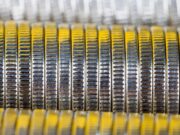Signs of de-dollarization are unfolding in the global economy. Here’s what you should know.
Efforts by the “BRICS” nations (Brazil, Russia, India, China and South Africa) as well as other major commodity exporters to loosen the dollar’s stranglehold on global commerce have ramped up amid the strains of steep U.S. interest rate rises and sanctions that have frozen Russia out of the global banking system.
Saudi Arabia and China have begun negotiations to settle Chinese oil sales with the yuan. Brazil and China have announced the phase-in of an arrangement for some yuan-clearing trade between the two countries. Russia and China are also now doing a significant portion of their trade in yuan.
While the dollar’s share of FX trading volumes remains high at just shy of 88% the U.S. share of global exports is now estimated at a record low 9% compared to record high 13% for China. China’s yuan now accounts for a record 7% of FX trading volume, while the euro’s slice has shrunk 8% over the last decade to 31%.
Although the greenback still holds the largest share of any global currency by far, a look at global trade shows a more bifurcated picture. Experts say these signs point to the beginning of global de-dollarization. With this in mind we’ve compiled this list of stocks that may become increasingly popular as the global de-dollarization continues to unfold.
Baidu Inc (BIDU)
Baidu, Inc. (BIDU) is a tech firm mainly providing internet search and online marketing solutions. BIDU’s products include Baidu App, Baidu Search, Baidu Feed, Haokan, Quanmin, and more. BIDU offers search-based and feed-based online marketing services, while iQIYI is its online entertainment platform. BIDU was founded by Xu Yong and Yanhong Li in 2000 and is based in Beijing, China. BIDU is up YTD by 19% and has a safe 0.67 beta. With a $49.29 billion market cap, BIDU has $18.4 billion in TTM revenue at $5.63 per share, profiting $1 billion on a 16.60% margin. BIDU has a P/E ratio of 13.7x, a forward P/E (NTM) of 12.1x, a 0.39x PEG, a P/S ratio of 2.47x, a P/B ratio of 1.36x, and a 37.80% D/E measure. BIDU has beaten analysts’ EPS forecasts for the last 13 consecutive quarters, surprising by 29.1% for its MRQ. BIDU shows excellent YOY growth in revenue (+9.62%), net income (+458.19%), EPS (+652.78%), and net profit margin (+701.39%), with a free cash flow of $16.75 billion and a 10-day average volume of 3.53 million shares. BIDU has a median price target of $173.67, with a high of $230.93 and a low of $110.95, representing a potential 94% price upside. Buy Now and Hold.
[stock_market_widget type=”accordion” template=”extended” color=”#5679FF” assets=”BIDU” start_expanded=”true” display_currency_symbol=”true” api=”yf”]
HDFC Bank (HDB)
As a major player in the digital payments space, India’s largest private sector lender, HDFC Bank, is in a favorable position to benefit from “the war on cash,” as the country’s economy continues to develop. The company has over 6,300 branches across more than 3,100 cities and towns. HDFC is also a player in the digital payments space and appears poised to benefit from “the war on cash.”
[stock_market_widget type=”accordion” template=”extended” color=”#5679FF” assets=”HDB” start_expanded=”true” display_currency_symbol=”true” api=”yf”]
Shell PLC (SHEL)
British oil major Shell recently announced plans to boost returns to shareholders and keep oil output steady. Shell said it would increase shareholder distributions to 30% to 40% of cash flow from operations, up from 20% to 30% previously. This includes raising the dividend per share by an 15% and executing at least $5 billion of share buybacks in the second half of the year.
“Performance, discipline, and simplification will be our guiding principles as we allocate capital to enhance shareholder distributions while enabling the energy transition,” said Shell’s CEO Wael Sawan , who took office at the start of the year after serving as director of the company’s integrated gas, renewables, and energy solutions. “We will invest in the models that work – those with the highest returns that play to our strengths,” he continued.
SHEL investors enjoy a dividend yield north of 4%. And the predicted payouts over the next couple of years are well covered by record historic earnings. So the near-term income prospects appear rock solid. In terms of valuation, the stock has a price-earnings ratio of 5.10, a price-sales ratio of 0.57 and an enterprise-value-to-sales ratio of 0.66. These numbers imply that Shell may be undervalued. The current consensus among 30 polled investment analysts is to buy stock in Shell. A median 12 month price target of $73.60 estimate represents a 22% increase from its current price.
[stock_market_widget type=”accordion” template=”extended” color=”#5679FF” assets=”SHEL” start_expanded=”true” display_currency_symbol=”true” api=”yf”]










